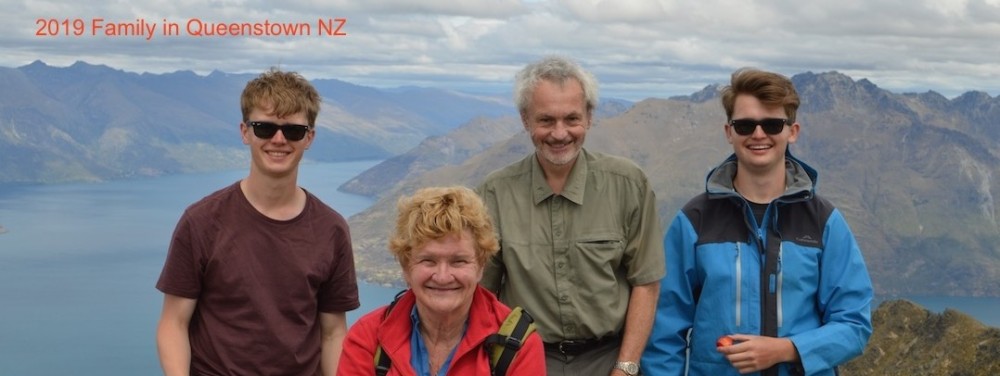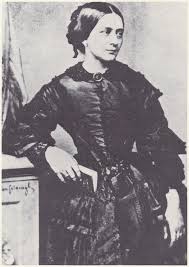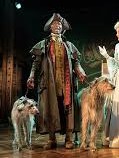SF favourites : a trilogy (3)
30 June 2018
And to conclude: three works of science fiction which have more literary pretensions than most. First of these, The Story of the Gardener by Phillip Mann, perhaps better known by the titles of its two volumes, Master of Paxwax and the Fall of the Families. Mann was born in Britain but has lived since 1969 in Wellington, New Zealand, where he is a professor of English and drama. According to Wikipedia, these two books are now regarded as classics of New Zealand literature, but they are not currently published in the UK. I don’t know their publication status in Australia, but they are worth seeking out so long as you approach them with no prior expectations.
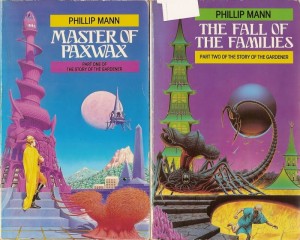 The books have been described, with some reason, as a revenge tragedy. Humanity has come to dominate the galaxy and, in doing so, has enslaved many alien races. But human society has become decadent, and humans suffer from a wide range of mutations and deformities. Meanwhile the aliens, led by the telepathic Craint, are plotting to overthrow the existing order and regain their freedom. Their chosen instrument is Pawl Paxwax, younger son and poet, who has succeeded by chance to leadership of one of the ruling human Houses, and has shown himself to be fair and generous but also passionate and fierce. By hurting Pawl through Laurel Beltane, his lover and wife, they provoke him to a vengeance that destroys the Families and frees the aliens.
The books have been described, with some reason, as a revenge tragedy. Humanity has come to dominate the galaxy and, in doing so, has enslaved many alien races. But human society has become decadent, and humans suffer from a wide range of mutations and deformities. Meanwhile the aliens, led by the telepathic Craint, are plotting to overthrow the existing order and regain their freedom. Their chosen instrument is Pawl Paxwax, younger son and poet, who has succeeded by chance to leadership of one of the ruling human Houses, and has shown himself to be fair and generous but also passionate and fierce. By hurting Pawl through Laurel Beltane, his lover and wife, they provoke him to a vengeance that destroys the Families and frees the aliens.
This is a very different story arc from, at a conservative guess, 99% of all other science fiction. Technology is de-emphasised, but the alien races are brilliantly realised: the terrifying Hammer, like scorpions big as a house; the gentle Gerbes, which betrays Pawl at the cost of its own integrity and life; the deadly Hooded Parasol which can kill by touch, scent or sight alone; the antique Craint, patiently plotting revenge. What will strike most readers, though, is the limpid storytelling. There is nothing here that a 12 year old could not understand. Sentences are short; vocabulary simple; nothing is concealed from the reader. The most difficult language is contained in Pawl’s poems, which are not the doggerel of many a fantasy epic but sophisticated creations worthy of an English professor. And the story gives us a succession of memorable images – the conclave of aliens, Pawl’s first encounter with the deadly Hammer, the green planet Ultima Thule on which he eventually finds a kind of peace. The effect is like a fable, and the conclusion in which the cruel Houses are destroyed feels both fitting and morally justified.
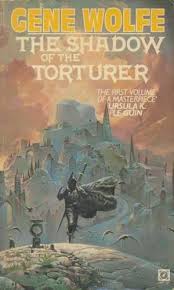 Another feted SF author, whose works are widely regarded as literary masterpieces by critics well beyond the SF community, is Gene Wolfe. He is as difficult, multi-layered and allusive as Mann is simple. His greatest work is the four-volume The Book of the New Sun, set in the farthest of futures on a dying earth. The sun has dimmed, and a once great starfaring civilisation has broken down. Technologies and alien artefacts seem strange and magical. The Book of the New Sun is generally regarded as science fantasy, and it has several of the trappings of conventional fantasy: a quest, a marvellous sword, betrayals, monsters. But a careful reading shows there is nothing supernatural or magical here.
Another feted SF author, whose works are widely regarded as literary masterpieces by critics well beyond the SF community, is Gene Wolfe. He is as difficult, multi-layered and allusive as Mann is simple. His greatest work is the four-volume The Book of the New Sun, set in the farthest of futures on a dying earth. The sun has dimmed, and a once great starfaring civilisation has broken down. Technologies and alien artefacts seem strange and magical. The Book of the New Sun is generally regarded as science fantasy, and it has several of the trappings of conventional fantasy: a quest, a marvellous sword, betrayals, monsters. But a careful reading shows there is nothing supernatural or magical here.
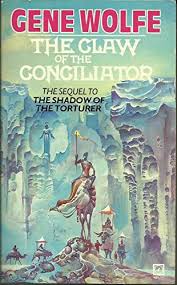 Wolfe challenges the reader to untangle many puzzles and mysteries in the course of these books. His protagonist, Severian, claims to have perfect memory; but just the same he is an unreliable narrator. He never, or rarely, makes statements that are later shown to be deliberate untruths, but he often lies by omission, and does not always understand what it is that he has experienced. Wolfe adds further complications by using obscure terminologies, but he never resorts to mere invention: thus social classes are denoted as exultants or peltasts, riding beasts similar to horses are destriers, liquid mercury is hydrargyrum, and so on. The ambiguity allows room for imagination, and reminds us that Severian’s world is very different from our own.
Wolfe challenges the reader to untangle many puzzles and mysteries in the course of these books. His protagonist, Severian, claims to have perfect memory; but just the same he is an unreliable narrator. He never, or rarely, makes statements that are later shown to be deliberate untruths, but he often lies by omission, and does not always understand what it is that he has experienced. Wolfe adds further complications by using obscure terminologies, but he never resorts to mere invention: thus social classes are denoted as exultants or peltasts, riding beasts similar to horses are destriers, liquid mercury is hydrargyrum, and so on. The ambiguity allows room for imagination, and reminds us that Severian’s world is very different from our own. 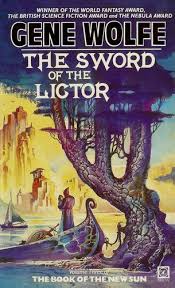 How many fantasy novels still have horses and apples, dukes and dungeons? Wolfe is not so lazy, and if we have to work harder, the rewards are greater.
How many fantasy novels still have horses and apples, dukes and dungeons? Wolfe is not so lazy, and if we have to work harder, the rewards are greater.
Something you will certainly notice if you read the books carefully, or more than once, is how cleverly Wolfe lays groundwork early for later developments, leaving his audience to gain added pleasure when they spot the hints. Quest novels, especially in the bloated form of much modern fantasy, are rarely so carefully plotted. Wolfe knows exactly what he is doing.
Critics have found various underlying themes in The Book of the New Sun. Some have suggested that it is a Vietnam allegory, which is surely wrong.  Others have seen Severian as a Christ figure, and you can certainly find many parallels between his life and Christ’s, though some require a good deal of interpretative imagination. One critic described The Book of the New Sun as science fiction’s Ulysses, but it’s a far easier read than Joyce. I think it better, myself, not to strain for interpretations, but to enjoy the story, the vivid images, the puzzles and the language.
Others have seen Severian as a Christ figure, and you can certainly find many parallels between his life and Christ’s, though some require a good deal of interpretative imagination. One critic described The Book of the New Sun as science fiction’s Ulysses, but it’s a far easier read than Joyce. I think it better, myself, not to strain for interpretations, but to enjoy the story, the vivid images, the puzzles and the language.
Wolfe’s reputation is formidable and the books can be intimidating to begin with (though not for their length: each individual volume is quite short). Don’t be put off: after a while you will tune in, like you tune in at the theatre to actors speaking Shakespeare or Congreve, and the payoff is well worth the effort.
And finally, another book whose language is part of the experience: River of Gods, by Ian McDonald. We are back in our own near future, in India mid-21st century. For once, the blurb on the back of my copy of the book does it fair justice:
As Mother India approaches her centenary, nine people are going about their business – a gangster, a cop, his wife, a politician, a stand-up comic, a set designer, a journalist, a scientist and a dropout… In the next few weeks they will all be swept together to decide the fate of the nation. River of Gods teems with the life of a country choked with peoples and cultures… the great Indian novel of the new millennium, in which a war is fought, a love betrayed, a message from a different world decoded, as the great river Ganges flows on.
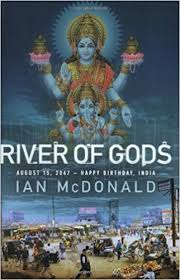 This is another novel told from several different perspectives which come together at its climax. The main strands in a complex, interwoven plot concern the shortage of water and the creation of self-aware artificial intelligence, but it is the atmosphere which makes this a unique piece of science fiction. McDonald scatters Indian words and phrases through the text, and I found his glossary less helpful than it might have been, but as in Wolfe the unfamiliar vocabulary is evocative, and meaning is usually clear from context.
This is another novel told from several different perspectives which come together at its climax. The main strands in a complex, interwoven plot concern the shortage of water and the creation of self-aware artificial intelligence, but it is the atmosphere which makes this a unique piece of science fiction. McDonald scatters Indian words and phrases through the text, and I found his glossary less helpful than it might have been, but as in Wolfe the unfamiliar vocabulary is evocative, and meaning is usually clear from context.
After I had written the rest of this blog, I found online a written interview with Ian McDonald (https://bit.ly/2IEcIP7) in which he gives a better account of River of Gods than I could ever manage. At the same time he implicitly criticises the template for much pulp SF, written to a formula with not much genuine imagination. I have read plenty of that stuff and enjoyed some of it; we may love haute cuisine, but gammon and chips can be good too. However, if you follow my recommendations I hope you will agree that there is not too much gammon about them.
- Firestar, Rogue Star, Lodestar and Falling Stars, by Michael Flynn
- Red Mars, Green Mars and Blue Mars, by Kim Stanley Robinson
- Cryptonomicon, by Neal Stephenson
- Snow Crash, by Neal Stephenson
- Dune, by Frank Herbert
- The Prefect (recently retitled Aurora Rising), by Alastair Reynolds
- Startide Rising, by David Brin
- The Night’s Dawn Trilogy (comprising The Reality Dysfunction, The Neutronium Alchemist, The Naked God) by Peter F Hamilton
- Gridlinked, by Neal Asher
- Altered Carbon, by Richard Morgan
- The Story of the Gardener (comprising Master of Paxwax and The Fall of the Families), by Phillip Mann
- The Book of the New Sun (comprising the Shadow of the Torturer, The Claw of the Conciliator, The Sword of the Lictor and The Citadel of the Autarch) by Gene Wolfe
- River of Gods, by Ian McDonald
——————–
SF favourites : a trilogy (2)
29 June 2018
My next recommendations are all set much further into the future. I wrote a while back (29 October 2017) about Frank Herbert’s Dune, which is unquestionably a classic SF novel, exploring issues of power, politics and environment in a way which was very rare at the time it was published. A must-read if you are at all interested in science fiction. You can skip all the sequels, though, by Herbert and others. The original novel is fully self-contained; everything that followed is redundant.
Let’s continue, instead, with Alastair Reynolds and his standalone novel The Prefect (recently retitled Aurora Rising, presumably for marketing purposes). Reynolds’ first novel was Revelation Space, a knotty, hard-edged far future where mankind has reached the stars but is still constrained by the lightspeed limit. There have been several sequels. The Prefect is set in the same universe but before the time of Revelation Space and is fully self-contained.
 Reynolds is one of the best current exponents of sense-of-wonder SF. His extrapolations from current science and technology are enormously bold and imaginative, but they remain fully believable. In The Prefect, humans occupy thousands of artificial habitats orbiting a single sun, each governed according to its own democratic choices: the Glitter Band. A separate sub-species of humans has developed, the Conjoiners, who live on their ships and travel between stars. The Band is loosely policed by an organisation called Panoply whose field agents are known as Prefects.
Reynolds is one of the best current exponents of sense-of-wonder SF. His extrapolations from current science and technology are enormously bold and imaginative, but they remain fully believable. In The Prefect, humans occupy thousands of artificial habitats orbiting a single sun, each governed according to its own democratic choices: the Glitter Band. A separate sub-species of humans has developed, the Conjoiners, who live on their ships and travel between stars. The Band is loosely policed by an organisation called Panoply whose field agents are known as Prefects.
The book follows events when a rogue human personality, transferred to a distributed computer brain, attempts to subvert the whole of the Glitter Band and in doing so risks precipitating war with the Conjoiners. Almost every chapter evokes a new wonder, and action moves from Panoply into space and down to (and below) the planetary surface. Reynolds is not a stylist, and his characters serve his narrative, rather than evolving from it, but this is a terrific story. Reynolds has written other novels with different settings, and is also a prolific short story writer, but of those I have read The Prefect is the most satisfying and approachable.
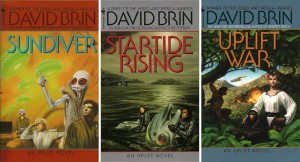 Unlike Reynolds, most other far-future SF writers are not satisfied to stay within the lightspeed limit. Most inventive of them all is David Brin, who has now written six novels set in his Uplift universe. The first three are standalones; the others are a trilogy and should be read in sequence. The central concept is that humanity has joined an aeons-old Galactic society of starfaring races. In this society, “patron” races have used genetic, biological and sociological techniques to uplift “client” races to sentience, creating unbreakable bonds of obligation. Those clients then go on to be patrons of other races. When (apparently) patron-less humanity arrives it is hated and despised for upsetting, and in some ways actively challenging, the status quo. Brin has a deal of fun imagining the various aliens and their technologies.
Unlike Reynolds, most other far-future SF writers are not satisfied to stay within the lightspeed limit. Most inventive of them all is David Brin, who has now written six novels set in his Uplift universe. The first three are standalones; the others are a trilogy and should be read in sequence. The central concept is that humanity has joined an aeons-old Galactic society of starfaring races. In this society, “patron” races have used genetic, biological and sociological techniques to uplift “client” races to sentience, creating unbreakable bonds of obligation. Those clients then go on to be patrons of other races. When (apparently) patron-less humanity arrives it is hated and despised for upsetting, and in some ways actively challenging, the status quo. Brin has a deal of fun imagining the various aliens and their technologies.
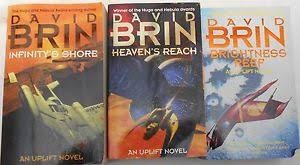 The second of the six books, Startide Rising, was the first that I read, and I’m inclined to think it is the best introduction. The first book in the sequence, Sundiver, is less ambitious and gives little flavour of the imaginative wonders to come. You can always return to it later. The fourth and fifth, Brightness Reef and Infinity’s Shore, are also very good, telling a complex story from multiple viewpoints, and bringing alien characters wonderfully to life; but the final volume of the trilogy, Heaven’s Reach, goes completely over the top and I find it impossible to suspend my disbelief. Disappointing. Brin has promised more in the series, and has left all kinds of loose ends to be tied off. I can’t wait.
The second of the six books, Startide Rising, was the first that I read, and I’m inclined to think it is the best introduction. The first book in the sequence, Sundiver, is less ambitious and gives little flavour of the imaginative wonders to come. You can always return to it later. The fourth and fifth, Brightness Reef and Infinity’s Shore, are also very good, telling a complex story from multiple viewpoints, and bringing alien characters wonderfully to life; but the final volume of the trilogy, Heaven’s Reach, goes completely over the top and I find it impossible to suspend my disbelief. Disappointing. Brin has promised more in the series, and has left all kinds of loose ends to be tied off. I can’t wait.
In a preface, Brin apologises to his readers for going “the trilogy route.” No such apology would be credible from the next author on my list, Peter F Hamilton, who is known for writing gargantuan narratives frequently split into two or three volumes, each the size of a doorstop. Hamilton is a writer of true space opera on an epic scale where we follow the actions of individuals against a background of conflict that threatens the entire status quo. His narratives are multi-stranded, yet brought together in satisfying denouements. His characters (nearly all of them human) are vivid and believable, though they don’t develop much.
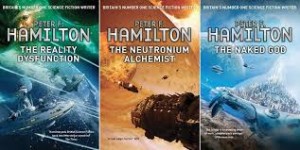 Of all Hamilton’s books I enjoy most the Night’s Dawn trilogy (1.4 million words), in which our universe is in danger of being overrun by an exotic phenomenon which brings the unquiet dead back to life as possessors of the living. Hamilton is unafraid of horror tropes, and some scenes are gruesomely violent (or merely gruesome), but this is definitely science fiction. Not for the squeamish, but otherwise recommended. There is a deus ex machina ending, but the groundwork for it is so carefully laid that it is, just, accepable.
Of all Hamilton’s books I enjoy most the Night’s Dawn trilogy (1.4 million words), in which our universe is in danger of being overrun by an exotic phenomenon which brings the unquiet dead back to life as possessors of the living. Hamilton is unafraid of horror tropes, and some scenes are gruesomely violent (or merely gruesome), but this is definitely science fiction. Not for the squeamish, but otherwise recommended. There is a deus ex machina ending, but the groundwork for it is so carefully laid that it is, just, accepable.
Hamilton has also written shorter, standalone novels, and his very first, Mindstar Rising, is a good representation of a future Britain after climate change has caused widespread flooding, with a strong narrative, a combat veteran as hero and a wicked political villain. But he writes best on the grand scale and (unlike many other SFF novelists) is able to keep his sprawling visions under control.
Sensitive readers might also want to avoid Neal Asher, a Tarantino of SF writing, whose stories are ultraviolent, profane and sometimes very funny. Asher’s first novel was Gridlinked, set in a far future where mankind has spread across hundreds of planets in a vast empire, the Polity. Government and industry are controlled by Earth Central, a massive artificial intelligence, and its array of subminds. But the Polity has its enemies: insurgents, hostile alien races which like eating people, and (as gradually emerges) a subversive, million-years-old alien virus which can subsume entire planets. To combat these threats the Polity uses a small number of human agents (James Bonds of the future), androids and robots. The protagonist of Gridlinked and its sequels is one such agent, Iain Cormac. In Gridlinked we see him overcoming an insurgent who has got hold of dangerous technologies.
 Asher is not so good at people. The most interesting characters in Gridlinked and its sequels are not Cormac and his allies but the rogues and villains, including a psychotic android and a bloodthirsty war droid. But Asher is a cunning hand at plot construction and at backstories: his technologies, his planets, his aliens and his existential threats are wonderfully imaginative. It’s a big, bad galaxy out there.
Asher is not so good at people. The most interesting characters in Gridlinked and its sequels are not Cormac and his allies but the rogues and villains, including a psychotic android and a bloodthirsty war droid. But Asher is a cunning hand at plot construction and at backstories: his technologies, his planets, his aliens and his existential threats are wonderfully imaginative. It’s a big, bad galaxy out there.
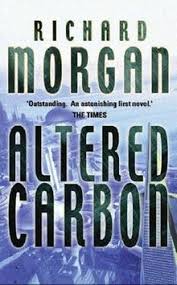 With Asher and Reynolds it’s hard to be sure whether what the worlds they describe are utopias or dystopias: they have elements of both. Hamilton and Brin are upbeat despite the traumas. But there is also a recurring dystopian theme in some modern science fiction, vividly exemplified by Richard Morgan’s Altered Carbon which might be characterised as cyberpunk noir. Morgan’s scope is narrower than Asher’s, but his story is equally violent and profane. In this imagined world, technology has opened whole new avenues for exploitation and degradation. Personalities can be digitised, transmitted across space or time, and downloaded into fresh bodies, synthetics or clones. The rich can thus extend their lives indefinitely through cloning: known as Meths (for Methuselahs), they are a race apart.
With Asher and Reynolds it’s hard to be sure whether what the worlds they describe are utopias or dystopias: they have elements of both. Hamilton and Brin are upbeat despite the traumas. But there is also a recurring dystopian theme in some modern science fiction, vividly exemplified by Richard Morgan’s Altered Carbon which might be characterised as cyberpunk noir. Morgan’s scope is narrower than Asher’s, but his story is equally violent and profane. In this imagined world, technology has opened whole new avenues for exploitation and degradation. Personalities can be digitised, transmitted across space or time, and downloaded into fresh bodies, synthetics or clones. The rich can thus extend their lives indefinitely through cloning: known as Meths (for Methuselahs), they are a race apart.
 Morgan’s protagonist, Takeshi Kovacs, is a classic noir hero, flawed but trying to do the right thing against all the odds. He has also been schooled in a revolutionary philosophy which espouses over-the-top vengeance against political and corporate exploitation. I’m not sure there is much more to Kovacs than attitude and role, but then, this is not a novel of character, any more than anything by Chandler or Hammett. Morgan went on to write two sequels featuring Kovacs, but they are closer to adventure stories (though with a cynical twist) than intrigues, and I don’t think they are quite so good. He has subsequently turned his hand to writing fantasy, much less memorable or distinguished. Altered Carbon has been turned into a television series by Netflix; it would be good if this proves a success and impels him back into the Altered Carbon universe.
Morgan’s protagonist, Takeshi Kovacs, is a classic noir hero, flawed but trying to do the right thing against all the odds. He has also been schooled in a revolutionary philosophy which espouses over-the-top vengeance against political and corporate exploitation. I’m not sure there is much more to Kovacs than attitude and role, but then, this is not a novel of character, any more than anything by Chandler or Hammett. Morgan went on to write two sequels featuring Kovacs, but they are closer to adventure stories (though with a cynical twist) than intrigues, and I don’t think they are quite so good. He has subsequently turned his hand to writing fantasy, much less memorable or distinguished. Altered Carbon has been turned into a television series by Netflix; it would be good if this proves a success and impels him back into the Altered Carbon universe.
 ——————–
——————–
SF favourites : a trilogy (1)
28 June 2018
A few weeks ago I wrote a couple of blogs about favourite books, and promised to return in due course to science fiction. I have plenty to choose from: five bookcases (a total of 24 shelves) devoted to science fiction and fantasy, split about 50/50 between the two genres. Some good writers have attempted both, and as we shall see there is also a hybrid genre of science fantasy, so let’s not be too picky. However, this blog will not deal with straight fantasy. Some other time, perhaps.
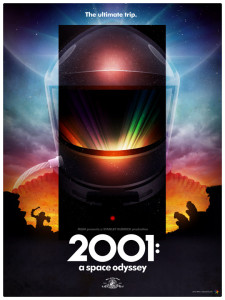 When I was a boy the three A-list SF writers were Isaac Asimov, Arthur C Clarke (one of whose short stories inspired the seminal SF film 2001) and Robert Heinlein. But I could not recommend any of their novels to a modern reader. They all now seem old-fashioned, and Heinlein’s brand of libertarianism is sometimes squirm-inducing. Asimov and Clarke, in particular, wrote “hard” SF, with a solid grounding in real science, and they have simply been overtaken by the real world.
When I was a boy the three A-list SF writers were Isaac Asimov, Arthur C Clarke (one of whose short stories inspired the seminal SF film 2001) and Robert Heinlein. But I could not recommend any of their novels to a modern reader. They all now seem old-fashioned, and Heinlein’s brand of libertarianism is sometimes squirm-inducing. Asimov and Clarke, in particular, wrote “hard” SF, with a solid grounding in real science, and they have simply been overtaken by the real world.
That is a danger peculiar to science fiction. Other genres grow old gracefully, so we can still read, say, Dorothy Sayers’ detective novels with pleasure; but SF that once predicted a future which is now our past is hard to take seriously. And in these golden age works of SF, if the science no longer conveys a sense of wonder, there isn’t much else to hold our attention: style is functional, characterisation basic, story (shorn of scientific trappings) often banal.
Perhaps in thirty years’ time people will be saying the same kind of things about some of today’s SF. I wrote on 28 November last about Michael Flynn’s Firestar series, which I greatly enjoyed, though it is no longer a story of the near future but of an alternative history. Flynn has a broader canvas than most of the golden age SF writers, drawing in themes of politics, intrigue, family drama and social criticism as well as science, technology and adventure. And, though you wouldn’t single out Flynn for his insight into character, the figures in his books are not just puppets; you can believe in them.
Flynn is not so well known even today. His chances of being remembered, let alone recommended, in thirty years’ time are not great. I hope, however, that a better fate will befall the other near-future SF on my recommended list: Kim Stanley Robinson’s Mars trilogy. I know of no other science fiction which is so rooted in science fact. Indeed, the first book in the trilogy, Red Mars, is the best fictional representation of the scientific mindset that I know. It is a generous representation, but also explores what can happen if scientists become too detached from the society which supports them.
 Robinson admits that he has a lifelong obsession with Mars, and it shows. He obviously has in his mind a detailed map of the planet’s surface, in the way that you or I might have a map of our neighbourhoods. He has studied deeply everything that is known about the planet’s geology, or more properly its areology*, including the surprising fact that there are vast quantities of water in the form of ice buried deep below its surface. The central theme of the trilogy is the terraforming of Mars, which necessarily involves a whole range of sciences: atmospheric chemistry, biology, hydrology, climatology and so on. This is known science, not speculation, but applied on a planetary scale. Robinson’s scientific speculations are mainly concerned with means of interplanetary travel, starting with today’s technologies and developing by increments over the three books. I suppose these may eventually be falsified by history, but they are plausible, interwoven into the plot and their consequences examined, not mere conveniences for the sake of story.
Robinson admits that he has a lifelong obsession with Mars, and it shows. He obviously has in his mind a detailed map of the planet’s surface, in the way that you or I might have a map of our neighbourhoods. He has studied deeply everything that is known about the planet’s geology, or more properly its areology*, including the surprising fact that there are vast quantities of water in the form of ice buried deep below its surface. The central theme of the trilogy is the terraforming of Mars, which necessarily involves a whole range of sciences: atmospheric chemistry, biology, hydrology, climatology and so on. This is known science, not speculation, but applied on a planetary scale. Robinson’s scientific speculations are mainly concerned with means of interplanetary travel, starting with today’s technologies and developing by increments over the three books. I suppose these may eventually be falsified by history, but they are plausible, interwoven into the plot and their consequences examined, not mere conveniences for the sake of story.
Robinson is not only concerned with the hard sciences: he extends his brief to encompass (among other things) psychology, sociology and economics. In counterpoint with the terraforming effort he gives us an account of the creation of a new society, struggling to free itself from Earth’s disastrous legacies of nationalism, exploitation, corporatism, environmental degradation and war. Each of the first two books ends with a Martian revolution, causing much unhappiness but resolving very little. The third book… well, let’s just say that, with lessons hard learned, it ends differently.
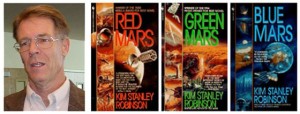 Robinson’s one departure from probable science is to imagine a medical technology which extends the human lifespan beyond 200 years. This enables him to maintain a core group of leading characters across the span of the three books. But, having imagined this technology, he also explores its implications, for both society and individuals. Once again, he doesn’t cheat for the sake of his story. And his characters are vividly realised: Sax and Anne, John and Frank, Maya and Hiroko, Nadia and Michel. There are few villains. Robinson gives them radically different viewpoints, through which he explores issues of science and society, but they feel like real people, not mere mouthpieces. This is light years away from golden age SF.
Robinson’s one departure from probable science is to imagine a medical technology which extends the human lifespan beyond 200 years. This enables him to maintain a core group of leading characters across the span of the three books. But, having imagined this technology, he also explores its implications, for both society and individuals. Once again, he doesn’t cheat for the sake of his story. And his characters are vividly realised: Sax and Anne, John and Frank, Maya and Hiroko, Nadia and Michel. There are few villains. Robinson gives them radically different viewpoints, through which he explores issues of science and society, but they feel like real people, not mere mouthpieces. This is light years away from golden age SF.
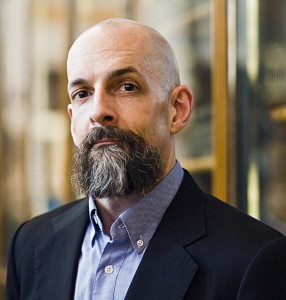 Most of my other SF favourites have settings far removed from today, but I should also mention Neal Stephenson, an author who like Robinson sometimes wears his learning on his sleeve but is otherwise about as unlike Robinson as you could imagine for an SF author. Stephenson’s masterpiece is supposed to be his Baroque cycle (a trilogy consisting of Quicksilver, The Confusion and The System of the World), a dense piece of quasi-historical fiction which in fact takes place in an alternate reality. But, despite making several starts on Quicksilver, I have never managed to come to terms with these books. I much prefer, and strongly recommend, Stephenson’s earlier single-volume Cryptonomicon, which explores similar themes.
Most of my other SF favourites have settings far removed from today, but I should also mention Neal Stephenson, an author who like Robinson sometimes wears his learning on his sleeve but is otherwise about as unlike Robinson as you could imagine for an SF author. Stephenson’s masterpiece is supposed to be his Baroque cycle (a trilogy consisting of Quicksilver, The Confusion and The System of the World), a dense piece of quasi-historical fiction which in fact takes place in an alternate reality. But, despite making several starts on Quicksilver, I have never managed to come to terms with these books. I much prefer, and strongly recommend, Stephenson’s earlier single-volume Cryptonomicon, which explores similar themes.
Not that Cryptonomicon is such an easy read. The book runs to just over 900 pages, including a lengthy annex about code making and breaking. There is a good summary in Wikipedia:
One group of characters are World War II-era Allied codebreakers and tactical-deception operatives affiliated with …. Bletchley Park …. The second [interwoven] narrative is set in the late 1990s, with characters that are (in part) descendants of those of the earlier time period, who employ cryptologic, telecom, and computer technology to build an underground data haven in the fictional Sultanate of Kinakuta.
![]() In fact the whole Wiki article is pretty good and includes my favourite four-word description of Cryptonomicon as the ultimate geek novel. Stephenson’s style is discursive, with lengthy digressions on various geeky topics like van Eck phreaking (look it up! – I did). Most of his technologies are obscure but real; but he also invents a secret society, the Societas Eruditorum, which seems to have unlocked the secrets of the alchemists, and an archipelago off the Scottish coast (possibly where the Hebrides ought to be) called Qwghlm, whose inhabitants’ strange language is perfectly suited to cryptology. Stephenson himself considers that these alternate-world elements, plus the strong technical themes, bring the book into the category of science fiction, and I am happy to go along with that.
In fact the whole Wiki article is pretty good and includes my favourite four-word description of Cryptonomicon as the ultimate geek novel. Stephenson’s style is discursive, with lengthy digressions on various geeky topics like van Eck phreaking (look it up! – I did). Most of his technologies are obscure but real; but he also invents a secret society, the Societas Eruditorum, which seems to have unlocked the secrets of the alchemists, and an archipelago off the Scottish coast (possibly where the Hebrides ought to be) called Qwghlm, whose inhabitants’ strange language is perfectly suited to cryptology. Stephenson himself considers that these alternate-world elements, plus the strong technical themes, bring the book into the category of science fiction, and I am happy to go along with that.
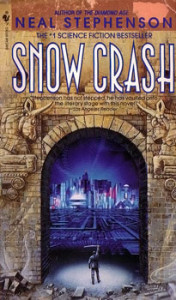 Despite all the digressions, Cryptonomicon has a strong narrative, a fascinating background and vivid (if geeky) characters. Highly recommended. If, however, you think a 900-page novel too intimidating a starting point, you could instead look at Stephenson’s earlier Snow Crash, which might be best described as a cyberpunk satire. It is set mainly in a corporatised future America where the federal Government struggles for relevance. Its principal characters are a sword-wielding computer hacker and a skateboard-riding courier, who get themselves entangled in the megalomanic plots of a corporate information tycoon (think Rupert Murdoch on a double dose of steroids). The Mafia has taken over the pizza delivery business, the police and the roads have been privatised, and the ancient technology which lies behind the myth of Babel is about to become terrifyingly relevant.
Despite all the digressions, Cryptonomicon has a strong narrative, a fascinating background and vivid (if geeky) characters. Highly recommended. If, however, you think a 900-page novel too intimidating a starting point, you could instead look at Stephenson’s earlier Snow Crash, which might be best described as a cyberpunk satire. It is set mainly in a corporatised future America where the federal Government struggles for relevance. Its principal characters are a sword-wielding computer hacker and a skateboard-riding courier, who get themselves entangled in the megalomanic plots of a corporate information tycoon (think Rupert Murdoch on a double dose of steroids). The Mafia has taken over the pizza delivery business, the police and the roads have been privatised, and the ancient technology which lies behind the myth of Babel is about to become terrifyingly relevant.
When Stephenson started on Snow Crash he thought he was writing the text for a graphic novel: it got out of control, but still has that exuberant quality, and an unstoppable narrative despite being, essentially, preposterous. Great fun, and a good introduction to Stephenson, but don’t expect Cryptonomicon and his later books to be quite so over-the-top.
*: Geology is named after the Greek Earth goddess Ge (also known as Gaia), so areology comes from the Greek Ares, equivalent of the Roman Mars.
——————–
Ministry of Flat Walks 12 : Rusland Pool and Bouth
15 June 2018
To follow this walk on a map, open another tab on your browser and input this address: https://bit.ly/2yct55S. The walk is mostly flat, but just after half way there is a noticeable climb for 200-300 yards which gave me some difficulty. However, if you take it slowly it is manageable. The length of the walk is about four miles, but some sections (not just the hills) are slow going. Allow two hours.
John and I have now completed this walk on two occasions. The second of these was today. The first was on Boxing Day in the year when we first spent Christmas at Cark. It was a memorable occasion, or perhaps I should say infamous. There was a bitingly cold wind against which, for the first half of the route, we had no shelter. The cold was so intense that it caused me physical pain around my ears. I told John that I was afraid my ears would drop off, which was not that much of an exaggeration. Ever since then we have thought of this as “the cold walk.” I now understand why Russians wear those funny hats with the ear muffs.
The walk starts at the river bridge on the A590, which is the main road that runs along the south edge of the map. The river is the Rusland Pool, a tributary of the River Leven. The A590 is a busy road, the main link between Furness and the rest of civilisation. But at this point the road has been straightened and widened, and on either side are long lay-bys where the old carriageway has been abandoned, so parking is straightforward. We parked in one such lay-by on the south side of the road, just west of the bridge.
Alternatively, if you are feeling bold, you could make use of the hotel car park on the north side. This hotel used to be called the Dickson’s Arms and my parents regularly enjoyed pub meals there. But recently its name has been changed to the Rusland Pool, and it now claims to be not a pub but an eatery, which tells you all you need to know. John and I had a poor excuse for dinner there a few years ago, and haven’t returned. With so many good eating-places nearby, why be sentimental about a former favourite that has fallen from grace?
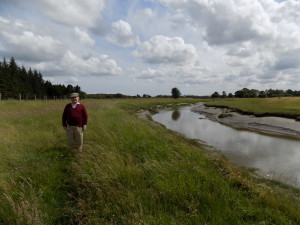 On the north side of the road, on the east bank of the river, you will find a signpost indicating a footpath to the north. There is a set of narrow steps down from the road to the river bank, but we found them almost completely overgrown, so take care. The path follows the river bank, which has been raised some feet above the surrounding marshy pastureland, presumably as protection against flooding. Today the water was low, muddy and sluggish, but it is easy to imagine how it might rise quite quickly after rain. The map shows the Rusland Pool at this point is not tidal, but I would not be surprised if spring tides make it this far upriver
On the north side of the road, on the east bank of the river, you will find a signpost indicating a footpath to the north. There is a set of narrow steps down from the road to the river bank, but we found them almost completely overgrown, so take care. The path follows the river bank, which has been raised some feet above the surrounding marshy pastureland, presumably as protection against flooding. Today the water was low, muddy and sluggish, but it is easy to imagine how it might rise quite quickly after rain. The map shows the Rusland Pool at this point is not tidal, but I would not be surprised if spring tides make it this far upriver
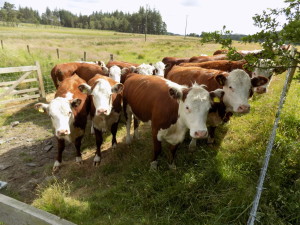 Although the line of the path is clear enough, the path itself is not, or at least was not so today: it was heavily overgrown with long marsh grasses. I would not care to venture along this path after a long period of wet weather, as it must become sodden and marshy. There are pastures on the flat ground either side of the river, with sheep and cattle grazing, but no arable land. The fencing is mostly new and in good repair, with gates rather than stiles for walkers.
Although the line of the path is clear enough, the path itself is not, or at least was not so today: it was heavily overgrown with long marsh grasses. I would not care to venture along this path after a long period of wet weather, as it must become sodden and marshy. There are pastures on the flat ground either side of the river, with sheep and cattle grazing, but no arable land. The fencing is mostly new and in good repair, with gates rather than stiles for walkers.
After about half a mile you come to a road which the map names The Causeway. Turn right here and then almost immediately left to continue following the riverbank. From here the path is clearer, and if you look around there is a pleasant rural scene, with the riverside pastures bounded on three sides with woodland and low hills.  Once you have left the traffic noise from the A590 behind you (this takes about a mile), the land feels quiet and remote. John was disappointed today not to see more butterflies and dragonflies to photograph, but he did find a truly spectacular moth, a six-spot burnet. I didn’t realise what it was until we got home and could look it up in one of Mum’s old insect books; I quite thought it might be a hornet, but I think John knew better. There were also a lot of birds, some of which we couldn’t identify, and birdsong.
Once you have left the traffic noise from the A590 behind you (this takes about a mile), the land feels quiet and remote. John was disappointed today not to see more butterflies and dragonflies to photograph, but he did find a truly spectacular moth, a six-spot burnet. I didn’t realise what it was until we got home and could look it up in one of Mum’s old insect books; I quite thought it might be a hornet, but I think John knew better. There were also a lot of birds, some of which we couldn’t identify, and birdsong.
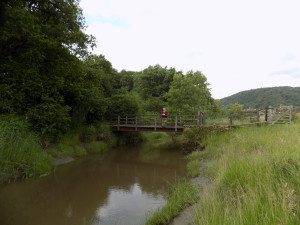 As you will see from the map, the path continues along the water’s edge to two footbridges: first Fish House Bridge, and a little way further upstream Crooks Bridge. We took Fish House Bridge (there is a ruined building on the west bank here, but nothing to show whether it is or was Fish House, or what significance the name might have) and followed the path broadly westwards. This path is well maintained, with boardwalks in places where the footing might become muddy after rain, though today it was dry as a bone.
As you will see from the map, the path continues along the water’s edge to two footbridges: first Fish House Bridge, and a little way further upstream Crooks Bridge. We took Fish House Bridge (there is a ruined building on the west bank here, but nothing to show whether it is or was Fish House, or what significance the name might have) and followed the path broadly westwards. This path is well maintained, with boardwalks in places where the footing might become muddy after rain, though today it was dry as a bone.
 After about another half mile the path emerges through a derelict gateway (one gatepost missing) into a paved country lane. Turn left here. Up to this point the walk has been more or less flat, but after the first bend this lane starts to climb, steadily and in one place quite steeply, past the farm buildings to a crossroads. The map is misleading here: the contour lines do not give a proper indication of just how steep this short stretch feels. But after the crossroads the worst is over. Continue on to a T junction with another lane, turn right and then left on to a grassy track that climbs over the brow of a hill and descends into the village of Bouth.
After about another half mile the path emerges through a derelict gateway (one gatepost missing) into a paved country lane. Turn left here. Up to this point the walk has been more or less flat, but after the first bend this lane starts to climb, steadily and in one place quite steeply, past the farm buildings to a crossroads. The map is misleading here: the contour lines do not give a proper indication of just how steep this short stretch feels. But after the crossroads the worst is over. Continue on to a T junction with another lane, turn right and then left on to a grassy track that climbs over the brow of a hill and descends into the village of Bouth.
There is an attractive-looking pub in Bouth, the White Hart Inn, if you feel in need of refreshment. Today we didn’t stop, but turned left and left again into the road which leads down to The Causeway. After 100 yards or so you will come to the first of two footpaths leading off to your right. 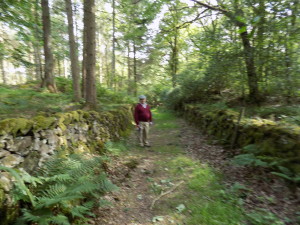 Ignore this one but take the second path, opposite a cluster of buildings, and descend down a grassy lane back towards the Rusland Pool. Today this lane was overgrown with nettles and brambles, so watch out for your hands and your clothes.
Ignore this one but take the second path, opposite a cluster of buildings, and descend down a grassy lane back towards the Rusland Pool. Today this lane was overgrown with nettles and brambles, so watch out for your hands and your clothes.
The path emerges from woodland and joins a farm track which leads back to the A590. This last section of the walk actually follows the line of a long-vanished railway siding, although you cannot see this on the map. From the mid-1700s up to the 1930s Cumbria was home to a thriving gunpowder industry. Gunpowder making was inherently risky and the works were sited in remote locations, with local resources of water power and charcoal ready to hand, but well away from human settlements. One of these gunpowder works was located at Black Beck – you can see the name on the map, a little way north east of Bouth. The railway siding connected the Black Beck works to the Furness Railway’s Lakeside branch about which I have written previously (see Ministry of Flat Walks 02). There is almost nothing left of the siding, certainly no trackwork or artefacts, but a keen eye will notice the characteristic railway brickwork where the line crossed over a culvert, and the farm track which now follows the line of the siding has some typical railway contours if you look out for them. I honestly think John found this the most interesting part of the walk.
Many thanks to John for his always excellent photographs.
——————–
Mrs Rich
14 June 2018
An article in the Guardian newspaper yesterday reported a campaign to have more classical concerts include work by women composers: “[The] Women in Music project finds that in 1,445 classical concerts across the globe only 76 include a work by a woman…”
I have no means of checking or confirming this figure, but from my concert-going experience it seems very likely to be true. Indeed, I would go further: very probably, all but perhaps half a dozen of those 76 will be from the 20th (or 21st) century. The only earlier women composers I have even heard of are Robert Schumann’s wife Clara and Felix Mendelssohn’s sister Fanny, both from the 19th century. But is this just my ignorance, or a reflection of an immutable fact, that before the 20th century few women wrote church or concert music, and less still of their music has survived?
The article caught my eye partly because, only last weekend, I went with John to see a production by the Royal Shakespeare Company of a play by an early 18th century female writer, Mary Pix. The play’s original title was The Beau Defeated, but for this production was retitled The Fantastic Follies of Mrs Rich. 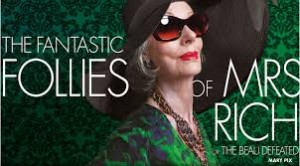 We wondered whether the change of name indicated that the play had been grossly updated from the original; the RSC’s own early publicity material suggested this might be the case. But in fact it seems to have been kept largely intact, though with some cuts for length and textual changes where the original language was overly obscure. Only the songs were new, and to my mind redundant. The full original text of the play can be found online at https://bit.ly/2JSFd0g.
We wondered whether the change of name indicated that the play had been grossly updated from the original; the RSC’s own early publicity material suggested this might be the case. But in fact it seems to have been kept largely intact, though with some cuts for length and textual changes where the original language was overly obscure. Only the songs were new, and to my mind redundant. The full original text of the play can be found online at https://bit.ly/2JSFd0g.
I had never previously heard of Mary Pix; but the theatre programme was quite helpful in placing her, and a search of Wikipedia more so. She lived from 1666 to 1709 and had a dozen plays produced in London between 1696 and 1706.
This puts her squarely among the Restoration playwrights (Congreve, Wycherley, Vanbrugh). Indeed, The Beau Defeated was first produced during the same season as Congreve’s The Way of the World, now generally considered his masterpiece, and of the two Pix’s play was initially the more successful.
She was not alone, but one of a small circle of “female wits” who also included Delarivier Manley, Catharine Trotter and Susanna Centlivre, all of whom wrote plays for the Restoration stage but are now almost forgotten. They were recognized as a group in their own time and were themselves the subject of misogynistic criticism and satire by, among others, Alexander Pope.
They were not precisely trailblazers. The previous generation had produced Aphra Behn, whose plays are still revived from time to time, especially The Rover which is now considered her best work and which John and I have seen twice, in different productions, at Stratford.
Behn appears to have been the first woman to earn her living through writing. Like Pix and the others, she faced down contemporary male criticism that it was no business of women to write plays. But later, more censorious times denounced their work for “immorality” when it was not simply forgotten, and only from the mid-20th century has it started to be rediscovered.
Was Congreve really so much better a writer, for his plays to have survived while Pix’s have been forgotten? As luck would have it John and I went only a few weeks ago to the latest revival of The Way of the World, at the Donmar theatre in the West End. The production was amusing and enjoyable, but I did not find I had much to say about it afterwards. However, it was easy to see in Mrs Rich many of the same qualities as in Congreve’s play – a complex but satirical plot mocking social mores and pretensions. If it had been Congreve who wrote The Beau Defeated, I doubt whether it would have disappeared from the canon.
But Congreve would not – could not – have written this play. Its true novelty lies in its feminine viewpoint. The central characters are two wealthy widows looking for new husbands. One, Mrs Rich, wants social standing, recognition, and a title. The other, Lady Landsworth, is looking for love, but distrustful of men’s inconstancy. There are two or three subplots to complicate matters. My one criticism of the play would be that the complexities became just a bit too tangled. But I might have said the same about The Way of the World.
Unusually for the RSC, I was not totally convinced by some of the performances. Sophie Stanton as Mrs Rich made the most of her role, a curious mixture of realism about what she wants and naivete about how to get there. She wore a pretentious piled-high wig, ill-fitting – I think deliberately. An unsubtle figure of fun, played without much depth, but she got the laughs. Daisy Badger as Lady Lambsworth was not so obviously ridiculous, but I don’t think she made the most of the absurdities of her actions (she disguises herself as a woman for sale in order to test and tempt the virtue of her hoped-for lover). Mrs Rich’s two hangers-on, Mrs Trickwell and Lady La Basset, were played with a kind of affected hysteria (or should that be hysterical affectation?) which did them no favours.
Among the men I liked Michael Simkins as Mrs Rich’s censorious brother-in-law and Solomon Israel as the younger Clerimont, Lady Lambsworth’s hoped-for lover: he managed to make the character’s bewilderment, torn between desire and duty, seem half-way real. Tam Williams as Sir John Roverhead was a bit too much of a caricature to make any impression. But arguably the stand-out performances were by the two dogs, Lossie and Theia, who accompanied the elder Clerimont and his huntswoman on stage. The show’s best moment of physical comedy came when all the characters on stage deserted a crestfallen Mrs Rich to fawn over the dogs, who I may say seemed completely unbothered by the attention.
The production was in full period costume, but with modern trappings. Music was provided by a saxophone quartet (the saxophone was invented more than a hundred years after Mary Pix’s death). The interpolated songs were written in a sub-jazz idiom whose deliberate anachronism was not jarring but seemed gratuitous. Does every comedy have to be turned into a musical? As usual on the apron stage at the Swan theatre, there were a minimum of props, but scene changes were denoted by a series of cloth backdrops on which the location was scrawled like graffiti. Effective, and perhaps necessary, but not subtle. Thinking about it now, perhaps the whole production was just a little too self-aware, not quite trusting Mary Pix’s words, characters and plot to speak for themselves. Not a flop by any means, but some of the Donmar’s straight playing of Congreve would not have come amiss here. Pix is good enough to stand on her own two feet.
 When the production first opened there was a snarky review by the Daily Mail’s columnist Quentin Letts, perhaps channeling his inner Pope, in which he suggested that Leo Wringer was unsuited to his role of the elder Clerimont and had been cast only because of the colour of his skin. This prompted an indignant response from the RSC. I did not think Wringer’s performance stood out either way: like the rest of the production it was broader than it was deep. The elder Clerimont is a caricature of a country squire as seen by city folk, not to be taken too seriously, and Wringer’s colour is completely irrelevant to the role. But it does seem ironic that this attempt to do belated justice to a female author, whose neglect may not be unconnected to her gender, might be sullied by the expression of a similar, equally unworthy, prejudice.
When the production first opened there was a snarky review by the Daily Mail’s columnist Quentin Letts, perhaps channeling his inner Pope, in which he suggested that Leo Wringer was unsuited to his role of the elder Clerimont and had been cast only because of the colour of his skin. This prompted an indignant response from the RSC. I did not think Wringer’s performance stood out either way: like the rest of the production it was broader than it was deep. The elder Clerimont is a caricature of a country squire as seen by city folk, not to be taken too seriously, and Wringer’s colour is completely irrelevant to the role. But it does seem ironic that this attempt to do belated justice to a female author, whose neglect may not be unconnected to her gender, might be sullied by the expression of a similar, equally unworthy, prejudice.
